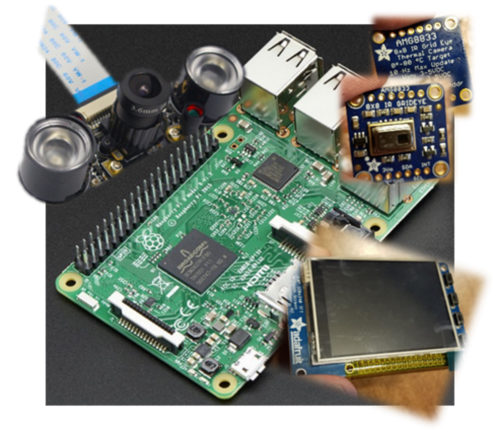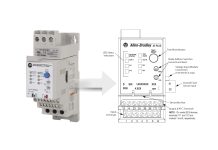
Editor’s Note: Paul, a senior automation engineer and experienced PLC programmer, reached out to me to ask if we’d be interested in publishing a series of articles about his side-project to build a simple system for temperature monitoring and process control. Since I have a number of home projects I’d love an excuse to automate, I took him up on his offer, and below is the first article in his series:
In hindsight, it was a little ambitious of me to decide that for my final project I was going to create something useful from scratch, and promise to follow it through implementation in an actual industrial process.
Honestly, I’m not sure how it will all turn out, but in this series I hope to take you through the journey with me.
 If you work in industrial automation you’re likely aware that there are well documented and established procedures and concepts of project management which should be followed when designing or planning upgrades for industrial applications.
If you work in industrial automation you’re likely aware that there are well documented and established procedures and concepts of project management which should be followed when designing or planning upgrades for industrial applications.
But when you’re working on a project after hours, and your goal is to build something quickly and application specific, it can make more sense to just work your way through the project as you go.
Of course, this often leads you to making quick decisions before thinking them all the way through, as well as having to jump through hurdles in an attempt to get the project to actually work.
In the end, sometimes you just have to do the best you can do to bring your idea to life, even if it means flying by the seat of your pants.
In this case, my lofty goal was to not only build something that would result in a good grade, but to also build something that was actually useful in the real world.
And in this series I’ll share my experience building a small process monitoring system, which hopefully will help if you have your own project to do.
My current project started as an idea to design and build a functioning (and cheap) color detection system.
Why? Because I wanted to…why else?
Joking aside, this was an idea I had from a previous course, and combined with some recent “work experiences” it’s what I decided to build for my senior design project (#donein21, #operationgraduate).
The idea was to take a few standard components (color sensor or camera) that could interface easily to a cheap processor, and make a go of making a working prototype with a side goal of seeing how many different processes it could be used in.
The concept was quickly changed by faculty after questions regarding targeted problems.
I myself saw no problems… so I had to invent one and went full force into how many sensors could I pack in small box in order to help with… ummm… well I wasn’t sure yet.
Instead of doing it “just because”, I had to get serious. So I found a process at work that could use temperature monitoring of process tooling.
I thought I could even tie in the monitoring of ambient temperature and humidity, as well as add the ability to view the process as well as store some images and data.
The result would be my custom system would provide the user with the ability to monitor a process that could help extend tool life and maybe even increase material quality.

That said, here’s what I ended up submitting in my project charter:
There has always been a need for continuous improvement in industrial processes, such as improving product quality or improving the efficiency of the equipment.
The problem I have observed many times is the availability of a single unit for measuring the missing connection between process operations, environment, and part quality.
This project will be to build a system targeted to be capable of imaging (image capture and live video feedback), surface temperature measurement using IR, and monitoring of ambient temperature and humidity.
This prototype intends to monitor the processing of metal wire, rod, and equipment tooling for the possibility of finding that connection for process improvement.
This system can be used for material presence and quality as well as process or tooling monitor for efficiency and cost savings…issues that could be corrected before causing costly re-work or reject material being shipped to a customer.
The main goal and purpose of this prototype system is to output values to an existing controller to assist in tool monitoring and checking continuous running surface temps (correlating to ambient) for efficient running speeds and possibly for defects on material caused by tooling failure.
Sounds impressive, right?. Now… what’s next?!?
First, to begin the build I’d need an enclosure for this system, but can’t chose one until I get all the components nailed down (assuming they have reliable size and mounting information) as well as what the environment conditions will be.
Finding out the environment conditions was easy enough… the area is temperature controlled and only occasionally gets slightly warmer in the summer. So just to be safe I decided to include a cooling fan.
Moving on to choosing the components, I realized I needed a scope-oriented to-do list to stay focused while still moving forward since I’m taking this project on solo with no teammates to share or delegate work to.
My initial list looked like this:
- Select Components based on needed functionality
- Design housing at targeted size
- Size of a mobile phone or handheld digital camera
- Purchase components
- Assemble, verify mounting and fit of components
There are several more steps beyond those first few, but Ill get into those as we go.
When it comes to component selection, I’m purposely choosing to use components that will make the system more modular (my hope is it will also be easier to design and build,) however this means I have to wait for some of the parts to arrive before I can confirm dimensions and mounting clearances.
In the next article, we’ll pick up with the arrival of the first batch of parts, and if there is interest continue the story through the building of two working prototypes before my final submission.
Written by Paul Hunt
Senior Automation Engineer and Freelance Writer
Have a question? Join our community of pros to take part in the discussion! You'll also find all of our automation courses at TheAutomationSchool.com.
Sponsor and Advertise: Get your product or service in front of our 75K followers while also supporting independent automation journalism by sponsoring or advertising with us! Learn more in our Media Guide here, or contact us using this form.
- Mitsubishi PLCs: Brief History and Hardware Overview - August 2, 2022
- Mitsubishi PLCs: FX5 vs iQ-R - February 10, 2022
- How To Register and Use a Device Profile in GX Works3 - November 9, 2021

Discover more from The Automation Blog
Subscribe to get the latest posts sent to your email.




